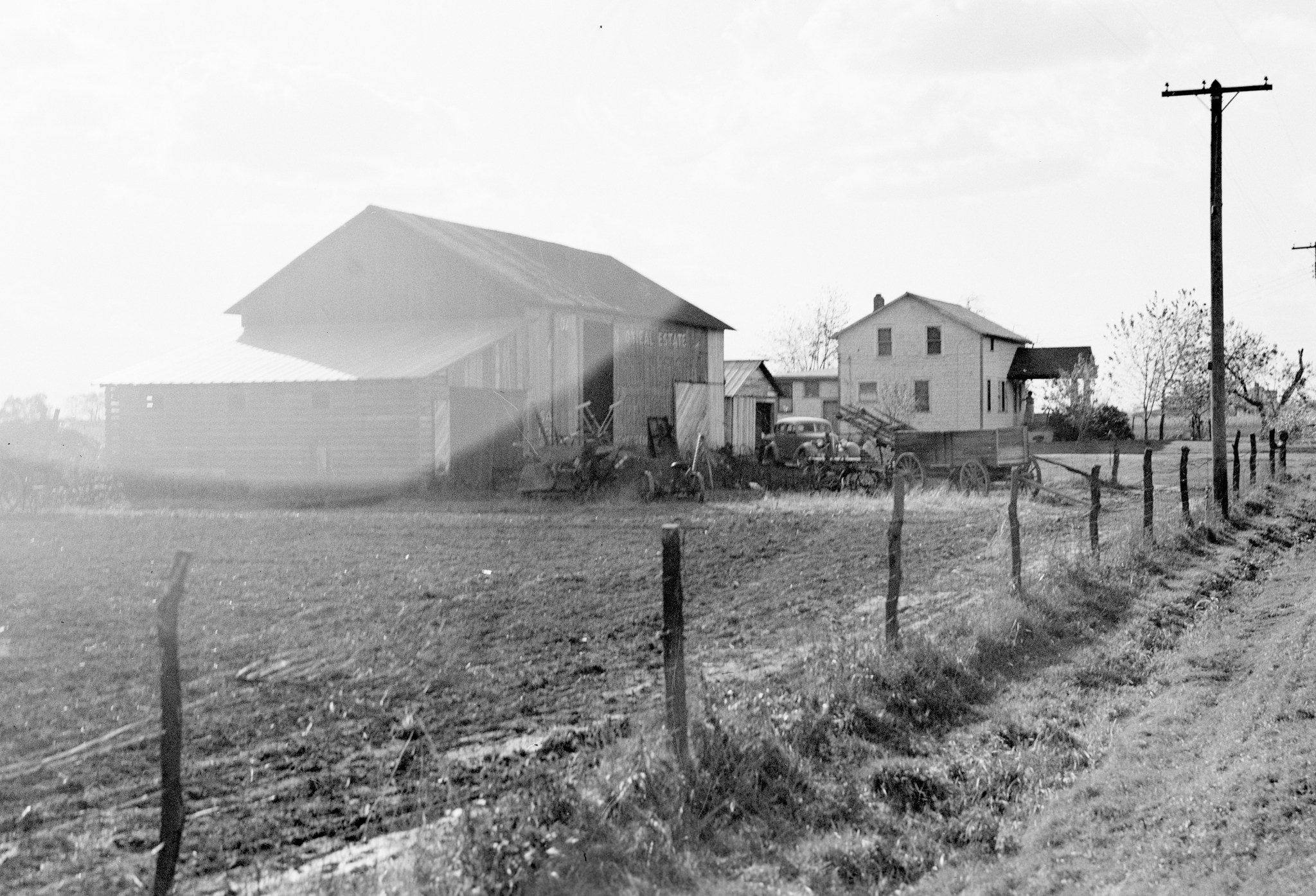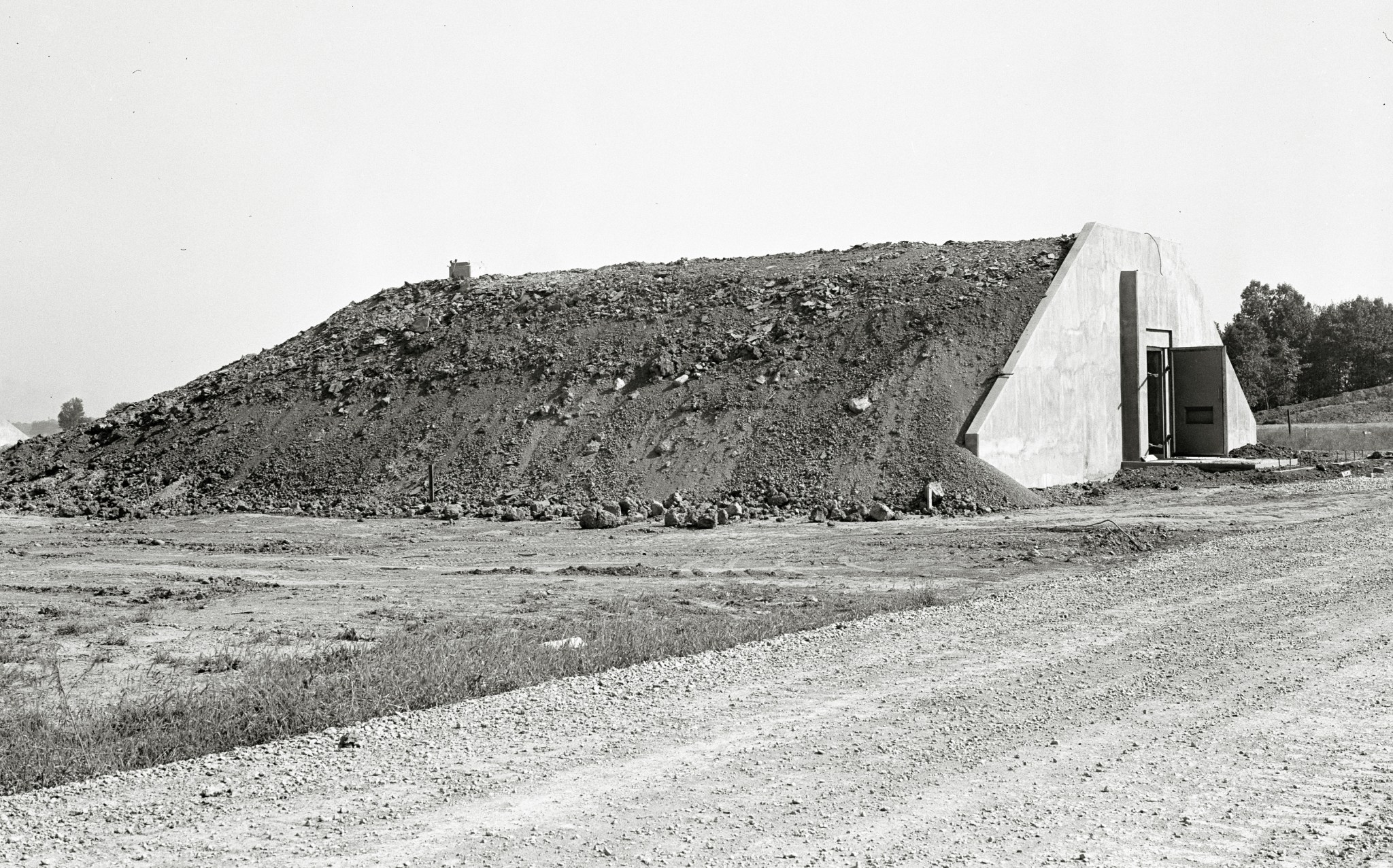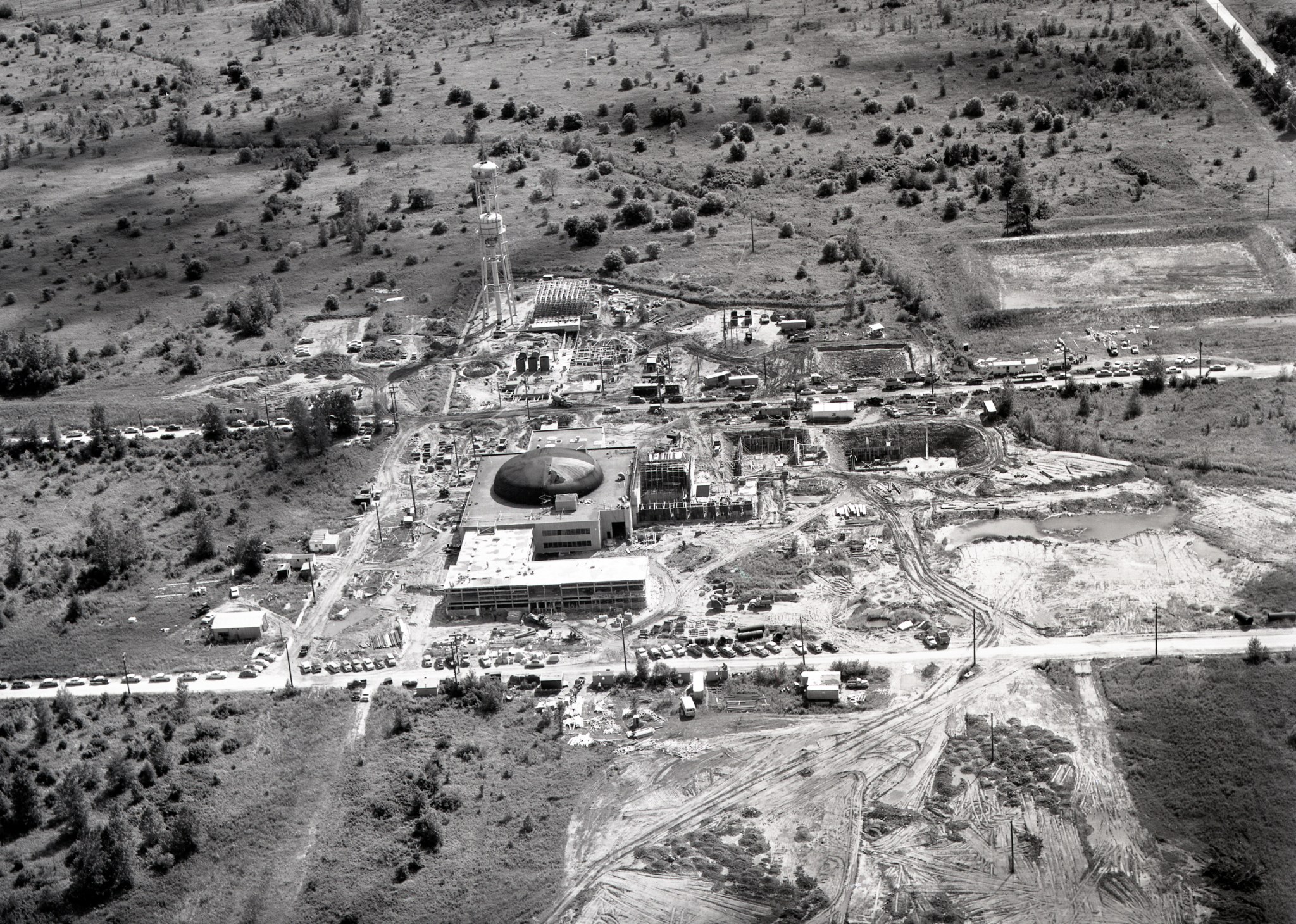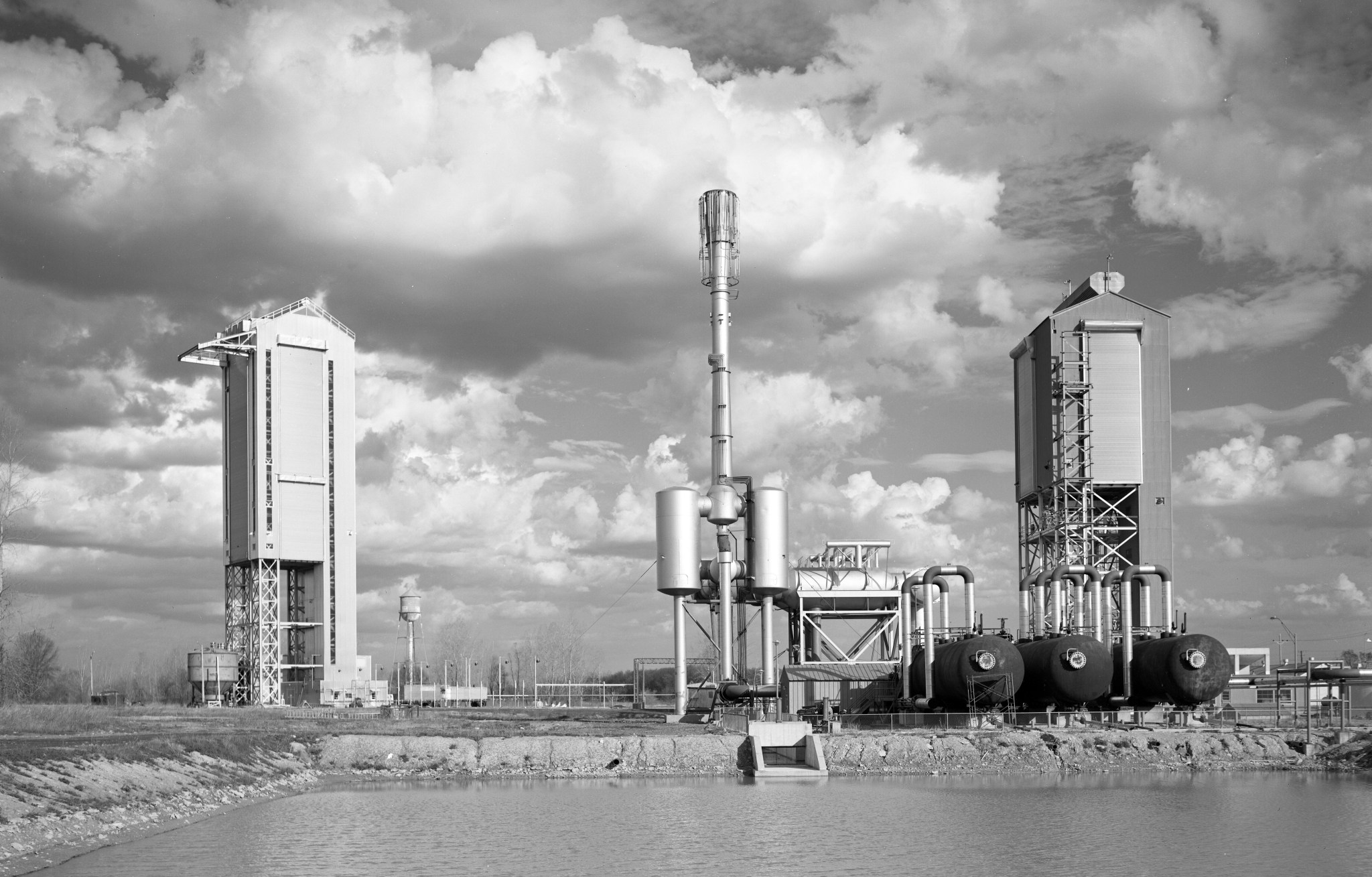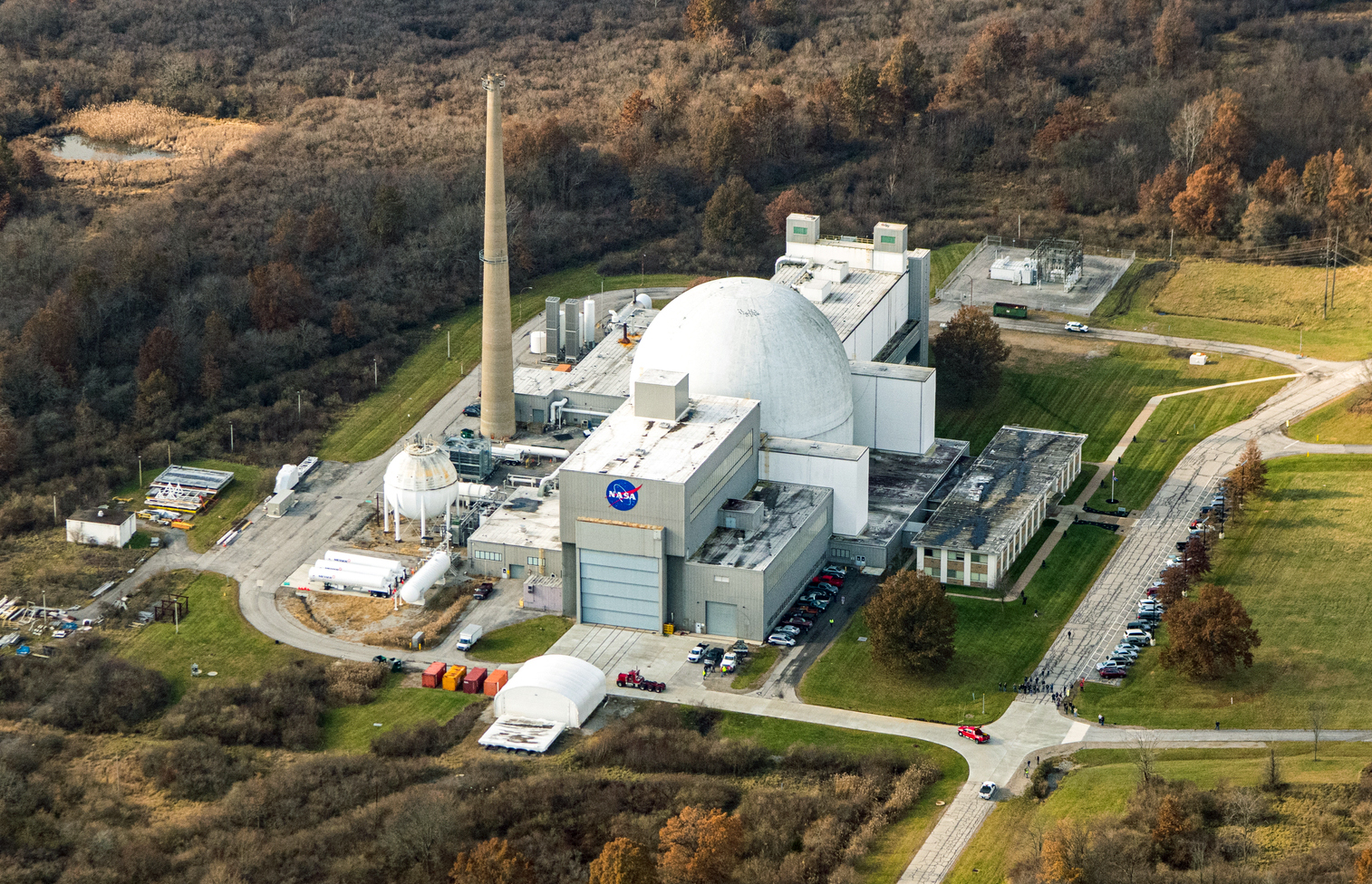
NASA’s Arrival in Sandusky
In the mid-1950s, the NACA sought a remote location to safely conduct testing for what is today NASA’s Glenn Research Center in Cleveland, Ohio. Following a multi-state search, officials opted for a former ordnance manufacturing complex in Sandusky to build Plum Brook Station (today, NASA’s Neil Armstrong Test Facility).
Site Selection for NASA’s Armstrong Test Facility
Formerly, Plum Brook Station
NASA’s Glenn Research Center has specialized in propulsion since its establishment in the early 1940s. Two elements of this work—nuclear propulsion and high-energy propellants—spurred the creation of the remote test facilities at Plum Brook Station (today, NASA’s Neil Armstrong Test Facility) in the late 1950s. The center, then known as the NACA’s Lewis Flight Propulsion Laboratory, needed a remote site to construct a test reactor to study the effect of radiation on engine materials. After examining a number of locations, the NACA selected a parcel at expansive the Plum Brook Ordnance Works in Sandusky, Ohio. The site, near the shores of Lake Erie, had been farmland for many years prior to its conversion into the ordnance plant for World War II.
The NACA, which transformed into NASA in 1958, subsequently acquired the entire 6400-acre property to construct additional test facilities to support the center’s liquid hydrogen research and to test large space systems. NASA has used the site (known as Plum Brook Station from 1963 to 2021) to conduct a wide range of testing, from small components to full-scale flight hardware. The station continues support NASA’s space missions today.
The Firelands
The site of NASA’s Armstrong Test Facility (ATF) in northwest Ohio was part of what is known as the Firelands. During the Revolutionary War in 1779, British troops burned several towns along the coast of Connecticut, which at the time stretched to the western edge of Lake Erie. In 1792, the state set aside 500,000 acres in present-day northcentral Ohio for those who lost their homes in the war. Development of the wooded area progresses slowly, but large swaths of the Firelands eventually became some of the most successful farmland in Ohio. The site’s location was relatively close to Lake Erie, and railroad routes and highways were constructed nearby.
Following the outbreak of hostilities in Europe in 1939 and 1940, the United States began mobilizing its industrial base its inevitable involvement in World War II. This mobilization included the seizure wide swaths of land in the middle of the country to construct massive munitions plants. On January 7, 1941 (two weeks before ground was broken in Cleveland for what is today Glenn Research Center) a government official arrived in Sandusky to announce the impending seizure of roughly 9000 acres of Firelands farmland to build what would become the Plum Brook Ordnance Works (PBOW). Despite protests and lawsuits, 150 homes, a town hall, and cemetery relocated in just a few months.
Plum Brook Ordnance Works
Between April and December 1941, the rural area was turned into a small industrial complex with hundreds of buildings and supporting infrastructure contained within its secure fence line. The PBOW included eight munitions plants, 99 semi-submerged concrete bunkers to store the explosives, and an array of temporary wooden structures, including dormitories and administrative buildings
The ordnance works began operation in mid-December 1941—just after the attack on Pearl Harbor. The PBOW operated continuously throughout the war to produce TNT, pentolite, and other explosives that were shipped to other facilities to be packed into shells and dispatched to Allied forces overseas. With 5,800 employees, the PBOW was the third largest ordnance facility in the nation. The facility exceeded its expected quotas and produced nearly one billion tons of explosives during the war.
The Japanese surrender in August 1945 brought an immediate cessation of operations at the facility. A private company managed the vacant property for the government between 1946 and 1949. During this period the government sold roughly 3,000 acres of perimeter area to local residents with the caveat that it could repurchase the land in 20 years. In 1949 the General Services Administration assumed control of the site and sought to properly mothball the facilities. Responsibility was transferred to the Ravenna Arsenal in 1954.
The NACA Establishes Its Presence
In the post-War years, researchers at the NACA’s Lewis laboratory were interested in the utilization of nuclear fission to power aircraft. Since they did not have access classified materials regarding the fission process, they focused their studies on the effects of radiation on materials that would be used to construct a nuclear engine, while the Atomic Energy Commission (AEC) worked on reactor designs. In early 1952, the Lewis laboratory concluded that a large test reactor would be needed to conduct the materials work in a meaningful way. The AEC approved the plans for the NACA’s reactor in 1954.
Since the reactor, its support buildings, and infrastructure would be too large to build at the Cleveland campus, the NACA hired a consulting firm to examine 19 different potential locations for the facility. They ranged from Cumberland, Maryland in the east to Sandusky in the west, and included several former ordnance facilities. The firm ranked the sites based on safety, cost, and proximity to the Lewis campus. By April 1, 1955, the NACA had decided to lease 500 acres at the Plum Brook site. After several months verifying that the plot was free of ground contamination, the NACA officially announced the selection on September 20, 1955. The next year was spent clearing the area of its structures and equipment. Local officials and NACA representatives convened at the site for a groundbreaking ceremony on September 20, 1955.
In the mid-1950s, NACA Lewis researchers were attempting to identify optimal combinations of experimental fuels and oxidizers that would maximize the energy yield without undue hazards or toxicity concerns. The work was performed at a series of small test cells referred to as the Rocket Lab at night or on weekends for safety reasons. In 1958, the NACA decided to lease additional 2,725 acres at Plum Brook to construct a collection of small facilities to study the combustion, pumping, and storage of these experimental fuels. This Rocket Systems Area also included two vertical test stands to test full-scale liquid-hydrogen fuel systems.
NASA Takes Over the Site
On October 1, 1958 the NACA became part of the new NASA space agency, and the laboratory was renamed the Lewis Research Center. Construction of the Plum Brook Reactor Facility and the Rocket Systems Area sites progressed in the midst of the abandoned ordnance works structures. NACA engineers and inspectors would travel from Cleveland daily to review the massive amount equipment, buildings, and unneeded infrastructure. Some of the materials and structures were repurposed for the new test facilities, but much was disposed of. Many of the wooden buildings were burned down and hazardous materials.
The reactor and many of the hydrogen sites became operational in 1961, and hundreds of employees were permanently stationed at Plum Brook. By this point, NASA was expanding both its facilities and the number of employees at Lewis and Plum Brook to meet the 1969 Moon landing target. On March 15, 1963, NASA permanently acquired the 3,200 acres it had been leasing at Plum Brook along with the site’s remaining 2800 acres and formally renamed the property Plum Brook Station.
Additional Information
To learn more about the subsequent research and testing at Plum Brook Station, please visit: NASA’s Neil Armstrong Test Facility History webpage.
To learn more about current capabilities at the site, please visit: NASA’s Neil Armstrong Test Facility webpage.
Armstrong Test Facility History
For over 60 years, NASA’s Neil Armstrong Test Facility (formerly known as Plum Brook Station) has provided researchers with a remote location to safely perform a wide array of testing to support the nation’s space program.
Learn More
























